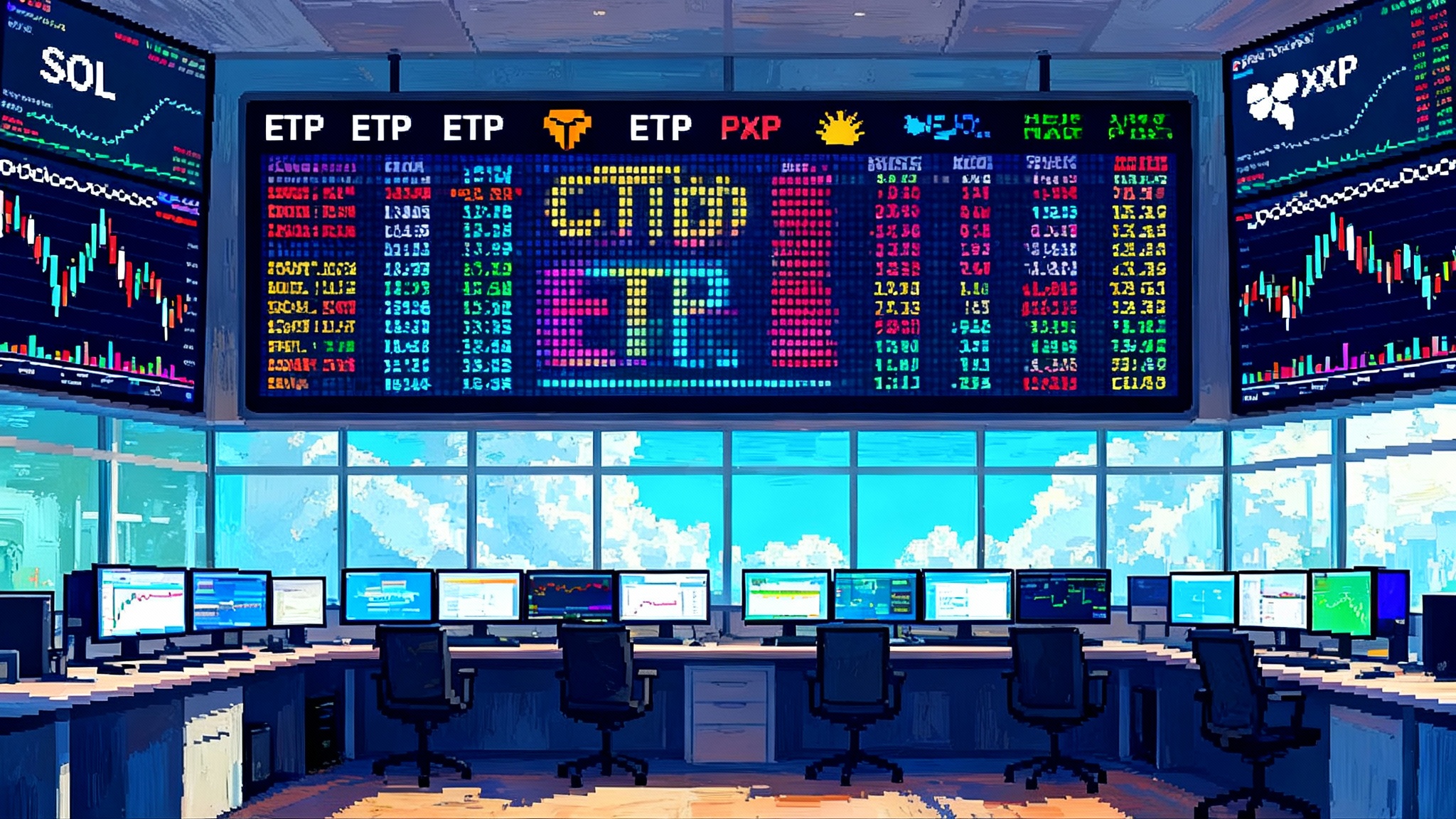Generic Listing Unlocks Solana, XRP and Memecoin ETFs
On September 17, 2025 the SEC approved generic listing standards that let U.S. exchanges list crypto commodity-based ETPs without case-by-case 19b-4 reviews. Here is what changes for Solana, XRP and even memecoins across eligibility, liquidity, spreads and options.

The rules-based pivot that changes everything
On September 17, 2025, the SEC approved generic listing standards that let U.S. exchanges list and trade Commodity-Based Trust Shares that hold spot commodities, including cryptocurrencies, without filing a separate 19b-4 for every product. This shifts the process from bespoke to standardized. The three major listing venues now have a single playbook they can use to bring qualifying crypto ETPs to market at speed. See the agency’s summary of the change in the SEC approval of generic listing standards.
Why this matters: until now, issuers endured a months-long gauntlet of filings, public comments, and uncertainty. With generic standards in place, issuers that meet the criteria can list under Rule 19b-4(e). The exchange posts required information within five business days after trading starts, and the market moves directly into price discovery. For background on existing products, see how spot Bitcoin ETFs work and the SEC approval of Ether ETFs.
What actually qualifies as generic for crypto
The order sets out clear paths that a commodity must meet to be eligible when used by a trust. In plain language, a single asset like Solana or XRP, or a basket index of several assets, can qualify if at least one of these conditions is true:
- The commodity trades on a market that is a member of the Intermarket Surveillance Group, and the listing exchange can obtain trading information from that ISG member.
- The commodity underlies a futures contract that has been listed on a designated contract market for at least six months, and the exchange has a comprehensive surveillance sharing agreement with that DCM.
- On an initial basis only, there is an exchange-traded fund with at least 40 percent exposure to the commodity that already lists and trades on a national exchange.
There are other structural guardrails. Trusts must publish detailed holdings every day and show market price, NAV, and the extent of any premium or discount. If a trust has less than 85 percent of assets readily available to meet redemptions on a daily basis, it must maintain documented liquidity risk policies and review them at least annually. The standards also spell out creation and redemption mechanics that allow either in-kind baskets or cash, which matters for spreads and tax efficiency. For a primer on oversight, see crypto market surveillance explained.
Taken together, these features make it feasible for single-asset altcoin products to list, and for multi-asset funds to scale. That includes large caps like SOL and XRP, and even memecoins if they can satisfy one of the eligibility paths and the operational requirements for custody, pricing, and surveillance.
Who benefits first
Expect a fast follower wave behind existing Bitcoin and Ether products. The SEC simultaneously approved the listing and trading of a large-cap digital asset fund that tracks a rules-based index, a template that removes the question of whether multi-asset baskets fit. Issuers with ready-built trust documents and service providers for custody, pricing, and audits can move quickly. The most likely near-term launches are single-asset trusts for tokens with robust spot and futures liquidity, followed by diversified large-cap indices that cap weights to reduce concentration.
Issuers will privilege assets that meet several tests at once: established custodial support at multiple qualified custodians, thick order books across top-tier venues, reference rates from more than one index provider, and clean legal histories. That points to SOL, XRP, and likely ADA, with DOGE, AVAX, and others in the on-deck circle if surveillance and liquidity align.
Liquidity and correlations: what changes when ETFs arrive
- U.S. hours matter more. ETFs concentrate trading during the cash session, which pulls price discovery into North American time. That often compresses spreads at the open and close and thickens volume around rebalances.
- Underlying markets adapt. Authorized participants and arbitrage desks will need to source and deliver coins in size. That increases the importance of deep, regulated spot venues and drives demand for clearing-like workflows across custodians.
- Basis trades proliferate. More capital will run the triangle of ETF shares, spot coins at custodians, and listed or perpetual futures for hedging. Expect tighter cash-and-carry spreads in assets with an ETF and looser spreads in those without.
- Beta and co-movement rise at first. New ETF flows often pull correlation higher as broad money buys the whole crypto complex. Over time correlations tend to fall again as product menus diversify into sector or factor exposures.
- Premiums and discounts stabilize. Daily transparency and arbitrage improve alignment between market price and NAV, especially if creations and redemptions happen in kind.
Creations, redemptions, and the AP math
The SEC signaled in July that crypto ETPs can use in-kind creations and redemptions, not just cash. That change is central to how spreads behave and how much capital market friction investors pay. See the agency’s note that it permits in-kind creations and redemptions.
Here is why in-kind is a big deal:
- Lower friction. APs can deliver the actual coins, not wire cash and wait for the sponsor to buy in the market. That reduces slippage and short-term impact, which narrows ETF spreads in active names.
- Inventory and hedging. Market makers can run tighter books when they can move between coins at custody and ETF shares without forced cash conversions. Hedging against perps or listed futures becomes more precise, especially around rebalances.
- Tax efficiency. In-kind redemptions let sponsors push out low-basis positions, which tends to reduce taxable capital gains distributions. Commodity trust structures aim to mirror this benefit.
- The hard part. Some tokens are difficult to borrow or to source in institutional size at predictable fees. When inventory is scarce, APs widen creation and redemption spreads. That shows up as wider ETF spreads on volatile days.
- Staking is a curveball. Many altcoins are proof-of-stake, but most commodity trust documents do not stake. That means the ETF may not capture staking yield. Issuers will need clear policies for handling airdrops, forks, and protocol distributions.
Options and the volatility surface that follows
Once spot ETPs for more assets list and season, listed options typically follow. That unlocks:
- Structured income. Covered call and cash-secured put strategies on altcoin ETFs become straightforward for RIAs and model portfolios.
- Volatility term structure. With listed options, the market discovers a forward vol curve for SOL, XRP, and others. That supports volatility-targeted strategies and dispersion trades versus BTC and ETH.
- Liquidity begets liquidity. As market makers quote ETF options, they hedge in the underlying ETF shares and in coin or futures markets. That deepens the entire stack, from on-exchange options to off-exchange block trades.
- Risk controls. Position limits, margin methodologies, and market-wide circuit breakers will matter more as exposures spread from two large coins to a roster of altcoins. Expect conservative limits at first.
Index construction will quietly pick the winners
For baskets and large-cap crypto funds, index rules drive flows. The details matter:
- Eligibility screens. Indices will likely require a minimum free float, minimum turnover across reputable venues, and a minimum number of independent price sources. Constituents must be custody-ready at scale.
- Capping and buffers. Caps prevent a single asset from dominating and reduce turnover whipsaw. Quarterly rebalances with buffer rules around cut lines limit churn.
- Corporate actions. Crypto has its own. Airdrops, token burns, and chain migrations need explicit handling rules. Indices that spell out cutoffs, valuation conventions, and what counts as investable will be easier to track.
- Pricing methodology. Volume-weighted composite benchmarks at set windows are common. Robust outlier filters and venue quality tiers are essential when assets lack a single central market.
Issuers will prefer indices they can replicate with limited slippage, since tracking error is a career risk. Expect several Core 5 or Top 10 families to emerge, each with slightly different rules.
Spillovers into DeFi and tokenization
- Collateral loops. As institutional money holds more coins at qualified custodians, on-chain liquidity providers may feel a relative squeeze. Spreads on decentralized exchanges can widen in tokens that see sustained ETF inflows unless market makers rotate capital back on-chain.
- Basis bridges. APs and quant desks will connect ETF flows to perps and basis markets across centralized and decentralized venues. That lifts demand for tokenized cash and T-bill tokens used as dry powder for hedging.
- Governance and staking. If the largest pools of coins sit in non-staking trusts, protocol participation can fall. That is manageable for big networks but could matter for smaller chains where validator concentration is already high.
- Tokenization flywheel. As mainstream investors get comfortable with crypto exposures through ETFs, they are more likely to allocate to tokenized money market funds, short-duration credit, or real-world asset pools. The brand effect is real.
The remaining hurdles that can still slow the rollout
Generic does not mean anything goes. Several gates still exist and can bite on timing:
- Surveillance access. If a token’s primary liquidity is on venues outside the ISG framework and there is no qualifying futures path, the exchange may not satisfy the surveillance-sharing test.
- The futures route. A qualifying futures contract must trade for at least six months on a designated contract market, and the listing exchange must have a comprehensive surveillance sharing agreement with that DCM. Not every altcoin has that today.
- The ETF bootstrap is one-time. Using an existing 40 Act ETF with 40 percent exposure to a commodity works only at initial listing. It does not replace ongoing eligibility.
- S-1 effectiveness still matters. Commodity-based trust shares are registered securities. The SEC’s Division of Corporation Finance can review disclosures, risk factors, valuation methods, and custody arrangements. That adds time.
- Pricing sources and halts. Trusts must have robust, manipulation-resistant reference rates. If a major venue halts trading or dislocates, ETF shares can trade at wider premiums or discounts.
- Custody and sanctions. Qualified custodians need token-specific policies for key management, travel rule compliance, and sanctions screening. For some assets, that stack is not yet battle tested at scale.
- Options listing is a second step. Even if an ETF lists, options need separate exchange approvals, OCC readiness, and prudent position limits. Early option markets can be thin until market makers get comfortable.
How to think about the next six months
- Timeline. For assets that clearly meet a generic path and have their registration statements ready, a near-term listing is realistic. Others will take longer to line up surveillance, pricing, and custody.
- Spreads. Expect wide-to-narrow behavior. Day one spreads can compress quickly if creations are in-kind and if APs can source coins without paying up.
- Flows. Early inflows chase simplicity: single-asset funds for the largest names and one or two diversified funds with recognizable indices and modest fees.
- Volatility. Short-term realized volatility can rise as the ETF opens a new flow channel. As arb capital scales, realized volatility often drifts lower, and implieds reprice.
Bottom line
The SEC’s generic listing standards mark a structural shift. Instead of debating every crypto product in isolation, the market now has a rules-based path that rewards operational readiness and surveillance access. That unlocks faster listings for mainstream altcoins and even some memecoins, provided they can clear the eligibility tests and build an institutional plumbing stack. In-kind creations, daily transparency, and the eventual build-out of listed options will reduce frictions and pull more liquidity into regulated rails. The rollout will still be uneven, and some tokens will wait on surveillance or futures milestones. But the gate is open, and the market infrastructure is ready to channel the flow.








